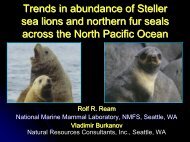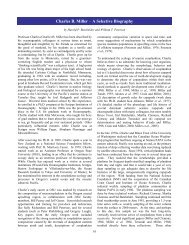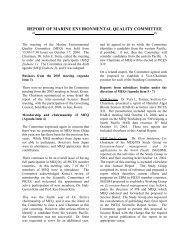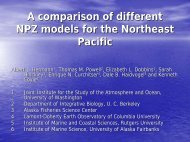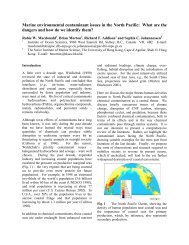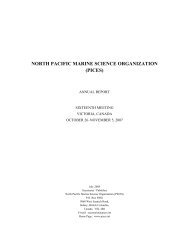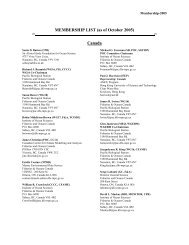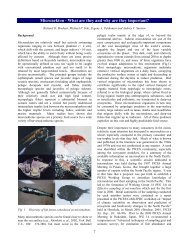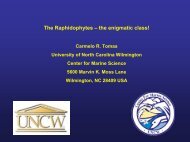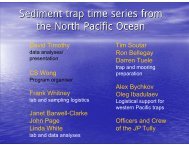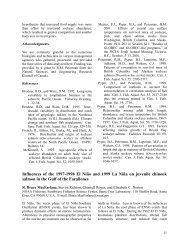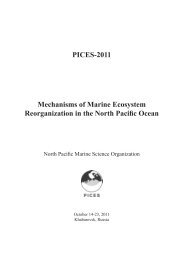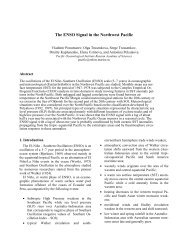Full Book - PICES
Full Book - PICES
Full Book - PICES
- No tags were found...
You also want an ePaper? Increase the reach of your titles
YUMPU automatically turns print PDFs into web optimized ePapers that Google loves.
<strong>PICES</strong> XIII S1-1827 PosterThe red flying squid (Ommastrephes bartramii): A review of recent research and thefishery in JapanJohn R. Bower 1 and Taro Ichii 212Northern Biosphere Field Science Center, Hokkaido University, 3-1-1 Minato-cho, Hakodate, 041-8611, JapanE-mail: akaika@fish.hokudai.ac.jpNational Research Institute of Far Seas Fisheries, 5-7-1 Shimizu-Orido, Shizuoka, 424-8633, JapanThis poster presents a review of the biology, ecology, fisheries, and resource status of the red flying squid(Ommastrephes bartramii) focusing on recent literature published in Japan. O. bartramii is a large oceanic squiddistributed in temperate and subtropical waters of the Pacific, Indian and Atlantic Oceans. The North Pacificpopulation comprises two cohorts (autumn and winter-spring) and four stocks: 1) central stock of the autumn cohort,2) east stock of the autumn cohort, 3) west stock of the winter-spring cohort, and 4) central-east stock of the winterspringcohort. The population undergoes a large-scale seasonal north-south migration. Spawning grounds occur insubtropical areas where the sea surface temperature ranges 21-25 o C, and feeding grounds occur in northern watersnear the Subarctic Boundary. O. bartramii matures at 7-10 months and has an estimated one-year lifespan. In theNorth Pacific, adult squid generally occur at 0-40 m depth at night and at 150-350 m during the day. They preyprimarily on fishes, squids and crustaceans. Predators include marine mammals and fishes. The North Pacificpopulation of O. bartramii was the target of an international driftnet fishery during 1978-1992, with annual catchesreaching more than 200,000 tons during the 1980s. It is now targeted by jigging boats from Japan, China, SouthKorea and Taiwan. Annual catches in the Japanese jigging fishery ranged from 50,000 to 80,000 tons during themid-1990s, but have since dropped. The cause of this drop is not known. In 2000, the biomass of the autumn cohortwas estimated to be about 370,000 tons. There are no recent biomass estimates of the winter-spring cohort. Thereview concludes with nine suggested areas for future research.<strong>PICES</strong> XIII S1-1818 OralArgo as an aid to environmental monitoring and assessment – An example from the Gulf ofAlaskaHoward J. FreelandInstitute of Ocean Science, P.O. Box 6000, Sidney, BC, V8L 4B2, Canada. E-mail: FreelandHj@pac.dfo-mpo.gc.caThe spring of 2002 saw an unusual climate anomaly develop within the waters of the Gulf of Alaska. This anomalywas characterized by rapid warming at the sea surface and an injection of a large T/S anomaly between 80 m to 150m depth. Much has already been written about the development and origin of this anomaly, and some descriptionsof its impacts have been prepared. In the northern Gulf of Alaska the anomalies resulted in a massive stabilizationof the water column through the spring and fall of 2002. By February 2003 it was apparent that very little verticalmixing had taken place in the upper ocean and that this would be restricting the supply of nutrients which potentiallycould be damaging to the productivity of the marine ecosystem. This paper will show how the unusual climateanomalies developed and how the Argo array allows us to monitor the development and evolution of a climateanomaly in near real-time. Evidence will also be shown implying that the anomaly appears to have been associatedwith large scale changes in the flow of water in the northern Pacific Ocean.4



